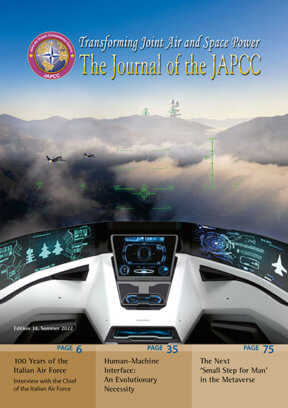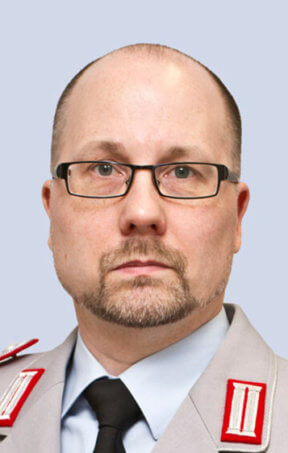Introduction
In recent years, the terms ‘swarm’ and ‘swarming’ have been among the most prevalent buzzwords in the uncrewed1 systems’ community, to include not only air vehicles but also land, maritime, surface, as well as underwater variants. However, what is a swarm or which common capabilities it needs to possess has not been officially defined. NATO’s uncrewed aircraft community has recently begun developing definitions for the above terms to eventually formalize the respective terminology for official use, but quickly stumbled as different communities have diverse interpretations and perspectives of what constitutes a swarm. Hence, an air-centric definition may not be well suited for the other domains.2
This article aims to outline the challenges and provides food for thought when discussing a future definition of ‘swarm’ and its related terms in the context of uncrewed vehicles.3
Purpose of a Definition
Every definition of terminology needs to fulfil a purpose; otherwise, it is not relevant and does not need to be defined. For instance, Remotely Piloted Aircraft (RPA) are defined as ‘unmanned aircraft that are controlled […] by a pilot who has been trained and certified to the same standards as a pilot of a manned aircraft’.4 Hence, using the term RPA indicates a certain degree of pilot qualification requirements to operate the aircraft. In the same fashion, it needs to be agreed which conditions and purposes are served by the definition, i.e. in which situations it is needed.
The challenge with defining ‘swarm’ is that the applicable uses differ significantly and that the defining parameters for one use may not be relevant to another. To outline this challenge, some examples are described below.
The Employment Use. Using a swarm for achieving a military effect is based on the military problem that needs to be solved. Swarm functions will only be employed when they promise a military benefit compared to other solutions. The desired effect will be, by nature, in line with the capability requirement definition and, therefore, within the legal framework of the procurer. Fielding swarm technology and operating it in line with applicable national and alliance legislation, Rules of Engagement, and Tactics, Techniques and Procedures will likely require a definition that provides statements about the military capabilities, modes of remote operation, means of command and control, as well as the level of human interaction.
The Developer Use. Potential swarm functions need to be well understood to identify military employment benefits from a developer’s perspective. Developing swarm technology and achieving the correct execution of swarming behaviour will likely require sophisticated levels of autonomy and artificial intelligence applications that enable a human to operate the swarm as a whole but do not require (or even allow) the control of any individual swarm entity. Therefore, a definition for this use is likely to be focused on the level of autonomy, its technical implementation into the hardware and software, and the adaptation of the swarm function into its system.
The Counter-Swarm Use. When observing and defending against a swarm, the level of autonomy or the means of command and control is not that important. From this perspective, the sheer number of entities, their observed behaviour, and their assumed swarm capability are the most relevant problems and thus, the defining elements, regardless of whether the swarm entities are manually controlled or operating autonomously. The challenge of identifying if a larger group of entities qualifies as a swarm increases with the complexity of the displayed swarming behaviour.
There may be other cases where a definition of the term ‘swarm’ may require deviations or alternatives to serve its purpose. To solve this dilemma, there are two options. First, develop multiple definitions for every use and, second, find a common denominator that could serve all (or at least most) uses. As multiple definitions bear the risks of confusion and misunderstanding between the different user communities, the second option is preferred. Each user community may later append its specific requirements to the general definition as subcategory terms, similar to the RPA, which is a subcategory under the overarching definition of ‘Uncrewed Aircraft’.
Common Denominator
This brings us to the challenge of identifying a common denominator for an overarching swarm definition. Commonalities can be found primarily by observing a swarm, particularly its behaviour, no matter if it comprises air, land, or maritime vehicles and regardless of whether the swarm behaviour is actually performed or only perceived. Hence, an overarching definition should start with the outside appearance and visual perception of a swarm and not focus on its inner workings. The latter may be covered and distinguished in subcategory terms.
Swarming Behaviour
In open-source research, numerous definitions of swarming behaviour are available, but they principally describe the same idea, often including swarm intelligence as a prerequisite. For example:
- ‘Swarming is the phenomenon in which a large number of individuals organize into a coordinated motion. Using only the information at their disposition in the environment, they are able to aggregate together, move en masse or migrate towards a common direction’.5
- ‘Swarm intelligence is the study of decentralized, self-organized systems that can move quickly in a coordinated manner’.6
- ‘In swarm robotics multiple robots collectively solve problems by forming advantageous structures and behaviours similar to the ones observed in natural systems, such as swarms of bees, birds, or fish’.7
- ‘Swarm Intelligence has been derived from the natural swarm behaviour of animals which can be defined as the collective behaviour exhibited by the animals of same size, aggregating together to solve a problem which is essential for their survival. Swarm Intelligence can be defined as the emergent collective intelligence of groups of simple agents’.8
Of note, ‘multiple swarm elements’ does in principle mean that any number of units greater than one, which are engaging in swarming behaviour to increase the collective capability of the overall units, can be considered a swarm. Since the identification of swarming behaviour is hardly possible without dedicated systems, it is advisable to consider multiple entities that seemingly operate together as a swarm unless proven otherwise. Higher numbers amplify the benefits of swarming behaviour. Also, the individual entities do not need to be identical, but simply compatible to solve a military problem as part of a swarm.
The common denominator of all the above definitions is the ‘coordinated movement’ of the individuals forming the swarm. Collective intelligence is also mentioned as a key element in realizing this behaviour; however, an observer will not be able to determine if a swarm’s coordinated movement is based on collective intelligence or through another means of control. Thus, collective intelligence is a secondary attribute to consider in an overarching definition and needs to be covered by subsequent terminology. Of note, future technologies, including artificial intelligence and machine learning applications, may enable an observer to determine if a large group of entities possesses extra swarm functions that could pose an increased threat. Therefore, ‘collective intelligence’ or similar identifiable swarm functions may be included in the definition.
Number of Individual Swarm Elements
Another key element of a swarm, inferred by the above definitions, is the number of entities involved without specifying a distinct minimum. Is there a threshold to be crossed to divert from traditional grouping schemes such as squadron, flight, or package to qualify as a swarm? Again, we have several options.
- Classify any formation of two or more elements as a swarm.
- Define a swarm as a group of individual elements that exceeds a specific number, higher than the aforementioned traditional groupings.
- Avoid any specificity and leave this detail again to subsequent taxonomy levels.
To refrain from being too restrictive and allow for subcategories, the last option is recommended. The term ‘multiple swarm entities’ expresses the proposed ‘non specificity’ quite well and will be used for this reason later in the article.
Spatial Distribution
The aforementioned observable characteristics, ‘coordinated movement’ and ‘multiple swarm elements’, do not imply a minimum or maximum distance between the individual swarm entities. There are already concepts of employing widely-distributed uncrewed aircraft to relay radio communications or provide internet connectivity to remote places. The distance between the individual air vehicles may be hundreds of kilometres to provide coverage over a large area. Even on a smaller scale, swarm entities may operate in a coordinated manner within only a few hundred metres of distance to observe an area or attack larger targets with multiple impact points. Whether such entities follow predetermined and uncoordinated patterns or perform coordinated actions may remain hidden for an observer, if the group (or swarm) cannot be surveyed in its entirety. The spatial distribution of a swarm is therefore not a qualifying factor for an overarching definition and would unnecessarily limit its application, although these characteristics may play a role in counter-swarm activities and be defined in subsequent terminology.
Human Interaction
The different levels of autonomy and the corresponding levels of human interaction are broadly discussed when talking about swarm technology. For example, the higher the level of autonomy, the lesser the requirement for human input during the actual mission. A swarm displaying a complete set of swarming behaviour is very likely to be at the upper end of the autonomy tiers, reducing the necessity for human interaction to a minimum. It can also be assumed that this human interaction applies to the whole swarm, to control the overarching swarm functions and not the individual swarm entities. However, the level of autonomy and the level of human interaction can hardly be determined when observing a swarm of individual air, land, surface, or sub-surface vehicles and is therefore not a relevant factor for an overarching ‘swarm’ definition. To not limit the applicability of the definition, these characteristics should be described in a sub-term, such as ‘Smart Swarm’, ‘Autonomous Swarm’, or similar wordings, as they certainly have applicability in research and development, swarm employment, and probably for legal purposes.
Swarm Capabilities
It is often assumed that forming a swarm enhances or generates a capability unachievable by individual systems alone. A swarm can be considered a system of systems which can execute predesigned functions and deliver one or more (military) effects. These effects benefit either directly from the swarming behaviour or indirectly from the composition of individual system capabilities as a combined swarm function. This benefit needs to be clearly understood from a capability requirement, employment, and defensive perspective, and can be linked to other military use definitions. In general, swarming behaviour is the foundation of any swarm capability. However, swarm capabilities may vary significantly depending on the type of systems used and, in contrast to swarm behaviour, cannot be observed but only assumed until performed. Therefore, capability statements are not deemed suitable for an overarching definition and should also be covered by subordinate terminology.
Definition Proposal
A definition depends on the swarm’s intended use. As swarm applications offer various uses, this article recommends beginning with an overarching definition and covering the individual use attributes in subordinate terminology.
The following is an overarching definition proposal that covers and supports all military domains and their respective uncrewed systems and, subsequently, each term of the definition is explained.
Formation. This should indicate the spatial correlation between swarm elements, while purposefully not describing their specific organization further. This leaves room to classify the various distances and spatial arrangements between the individual swarm elements into subcategories.
Multiple. Swarms may consist of a handful or even hundreds of elements, but at least more than one. The unspecific term ‘multiple’ allows the definition to work for all types of swarms, regardless of their participating elements. Defining a specific number will also be difficult for any subordinate terminology. One distinction could be made between ‘countable numbers’ in a small swarm and ‘uncountable numbers’ in a large or massive swarm which may be helpful, for example, to distinguish the threat when a human or technical system is simply overwhelmed by the approaching entities.
Entities. It covers all categories of uncrewed vehicles, including air, land, surface, and sub-surface systems. This term can also work for the cyber and space domains if coordinated actions of computer programs or satellite systems are future options for NATO to pursue. Subordinate terminology could be considered, for example, Uncrewed Aircraft Systems Swarm (UASSw)9 or Uncrewed Surface Vehicles Swarm (USVSw).
Display Coordinated Behaviour. The inner workings and technical mechanisms of arraying a swarm can differ and for some uses the definition may not even require a review of these internal characteristics. The common denominator identified in this article is the swarm’s behaviour consisting of coordinated manoeuvres and actions that can be observed. It deliberately does not state how those coordinated actions are achieved. The technical means to enable swarm functionality can be expressed in subsequent terminology, such as ‘autonomous swarm’ or ‘intelligent swarm’.
Towards an Objective. This serves the military context, as it can be assumed that a swarm is always directed towards an objective to achieve its given mission goal, ranging from simple site survey, intelligence, surveillance, and reconnaissance, to strike or suicide missions. This may not be relevant outside the military context and could be left out.
Conclusion
Finding an agreed definition for ‘swarm’ is a difficult challenge as there are plenty of uses across all military domains and civilian applications. The only solution for achieving broad acceptance of a swarm definition within NATO is to identify the common denominator of all swarm characteristics, reduce the definition to a minimum, and leave the specifics for dedicated uses to subordinate terminology.













